Unbounce and VWO are two leading platforms in the world of conversion optimization, offering businesses the tools they need to boost their marketing efforts. While Unbounce is renowned for its intuitive landing page builder, VWO is a powerhouse in A/B testing and experimentation.
Both platforms aim to help marketers drive better results, but they cater to slightly different needs. With Unbounce’s focus on creating high-converting landing pages and VWO’s robust analytics and testing capabilities, the choice between the two often depends on your specific goals and workflow requirements.
In this guide, we’ll explore the key differences between Unbounce and VWO to help you determine which platform aligns best with your marketing strategy. Whether you’re looking to create visually stunning landing pages or fine-tune your campaigns through data-driven experiments, we’ll provide a side-by-side comparison of their pricing, features, integrations, and unique offerings.
Let’s dive into the details to find the right fit for your needs!
Unbounce vs VWO: Main Differences
Unbounce and VWO are powerful tools designed to improve your marketing outcomes, but they serve different purposes and excel in unique areas. Here’s a quick overview of their primary differences:
| Aspect | Unbounce | VWO |
|---|---|---|
| Core Focus | Landing page creation and optimization | A/B testing, heatmaps, and conversion rate optimization |
| Ease of Use | Drag-and-drop builder with no coding required | Requires some technical expertise for advanced experimentation |
| Customization | Fully customizable landing pages | Focuses on optimizing existing pages |
| Testing Capabilities | Basic A/B testing for landing pages | Advanced testing, including multivariate and split URL tests |
| Analytics | Basic performance insights | Comprehensive data insights with heatmaps and session recordings |
| Integrations | Wide range of integrations for CRM, email, and analytics | Integrates with advanced analytics and marketing platforms |
| Target Audience | Marketers focused on landing page design | Marketers and data analysts focused on improving conversions |
| Pricing | Starts from $99/month | Custom pricing based on tools and features |
Unbounce is the go-to platform for marketers who want to design visually appealing, high-converting landing pages without needing coding skills. It’s perfect for businesses aiming to launch campaigns quickly while maintaining design flexibility.
On the other hand, VWO shines in helping businesses optimize existing web pages and campaigns through advanced testing and behavioral analysis tools. With its focus on experimentation and data-driven improvements, it’s an ideal choice for those who want to dive deep into analytics and conversion rate optimization.
By understanding these fundamental differences, you can better assess which platform aligns with your specific marketing needs and goals.
How Does Unbounce and VWO Compare?
Unbounce
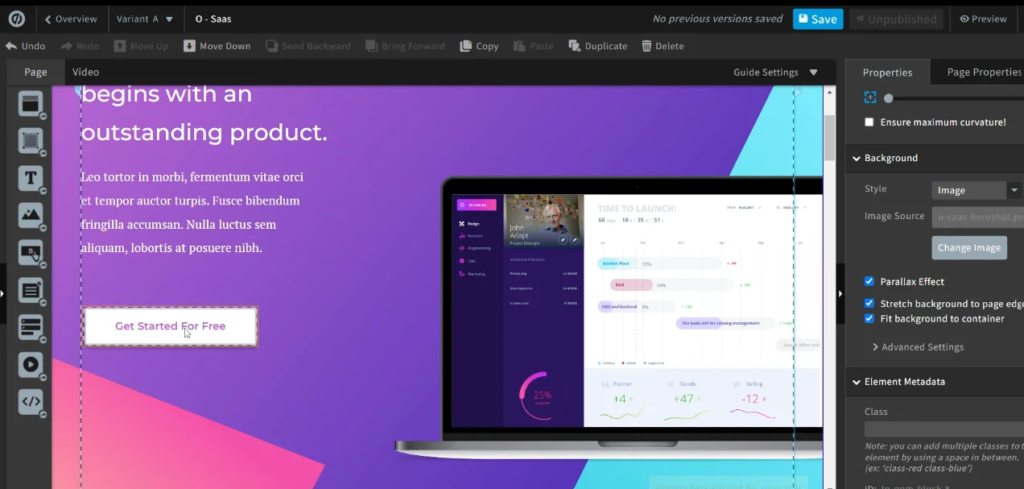
Unbounce is a user-friendly platform designed to help marketers create high-converting landing pages without needing any technical expertise. The platform is known for its drag-and-drop page builder, extensive template library, and robust optimization tools.
Key Features of Unbounce:
- Landing Page Builder: An intuitive drag-and-drop interface that allows you to design and publish landing pages quickly. The builder offers full customization, letting you add elements like forms, videos, images, and more.
- Smart Traffic: Unbounce’s AI-powered tool automatically directs visitors to the variant most likely to convert based on their behavior.
- Templates: A library of 100+ professionally designed templates optimized for various industries and conversion goals.
- Pop-ups and Sticky Bars: Tools to capture leads and drive engagement with customizable pop-ups and sticky bars.
- A/B Testing: Run split tests on your landing pages to find the highest-performing variants.
Advantages of Unbounce:
- Easy to use for marketers of all experience levels.
- Eliminates the need for coding with a flexible builder.
- Integrates with major CRM, email marketing, and analytics tools.
- Mobile-responsive design capabilities.
Drawbacks of Unbounce:
- Limited focus on advanced experimentation or behavioral insights.
- Best suited for creating new pages rather than optimizing existing ones.
VWO
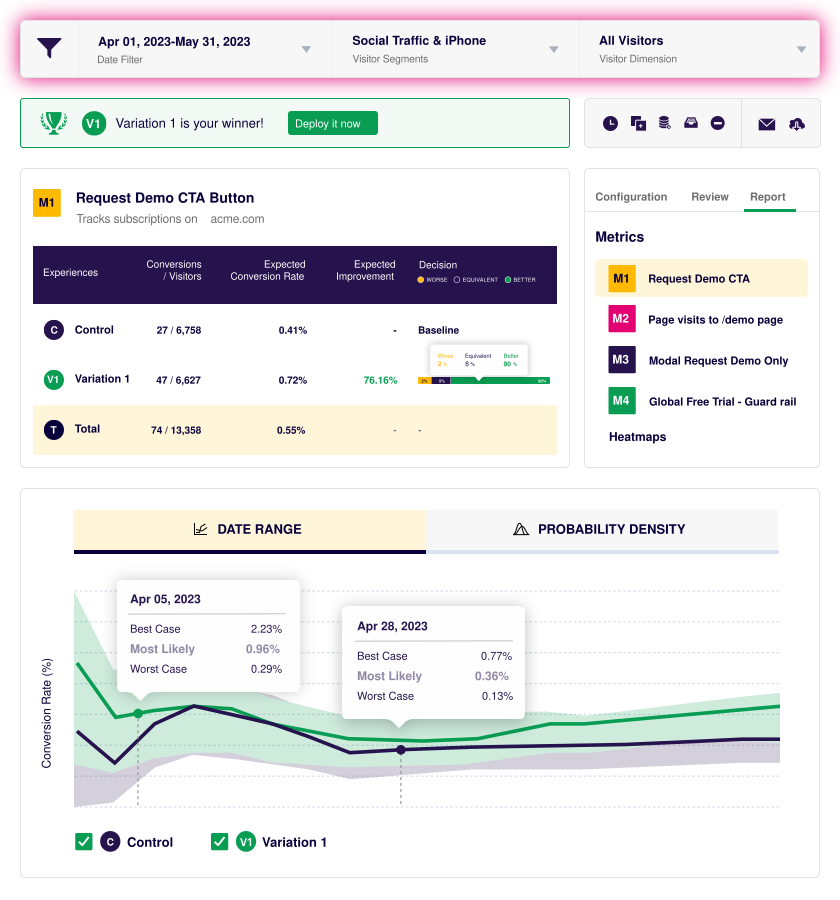
VWO is a comprehensive platform for conversion rate optimization (CRO), offering tools to experiment, analyze, and improve website performance. It focuses on testing and behavioral analysis to help businesses fine-tune their marketing strategies.
Key Features of VWO:
- A/B Testing: Advanced testing tools allow you to experiment with multiple variants of your web pages and identify the best performers.
- Multivariate Testing: Go beyond simple A/B tests to analyze the impact of multiple changes on page performance.
- Heatmaps and Session Recordings: Gain insights into user behavior by tracking clicks, scrolls, and navigation paths.
- Funnel Analysis: Identify where users drop off in the conversion journey and optimize those touchpoints.
- Personalization: Create tailored experiences for different audience segments based on behavior, location, or demographics.
Advantages of VWO:
- Robust testing capabilities, including multivariate and split URL tests.
- In-depth behavioral analysis through heatmaps, session recordings, and form analytics.
- Focused on improving the performance of existing web assets.
- Ideal for teams that want to make data-driven decisions.
Drawbacks of VWO:
- Steeper learning curve, especially for advanced testing features.
- Requires some technical knowledge for implementation and integration.
- Limited tools for creating entirely new landing pages.
Unbounce is perfect for businesses seeking a fast and easy way to create and launch new landing pages, while VWO is best for teams focused on in-depth optimization of their existing web pages through data and testing. Each platform caters to distinct needs, and your choice will largely depend on whether you’re building from scratch or refining current assets.
Unbounce vs VWO: The Templates
Unbounce
Unbounce offers a robust library of templates designed to help users create visually appealing and high-converting landing pages. With over 100 professionally crafted options, these templates cater to various industries and goals, including lead generation, e-commerce, and event registrations.
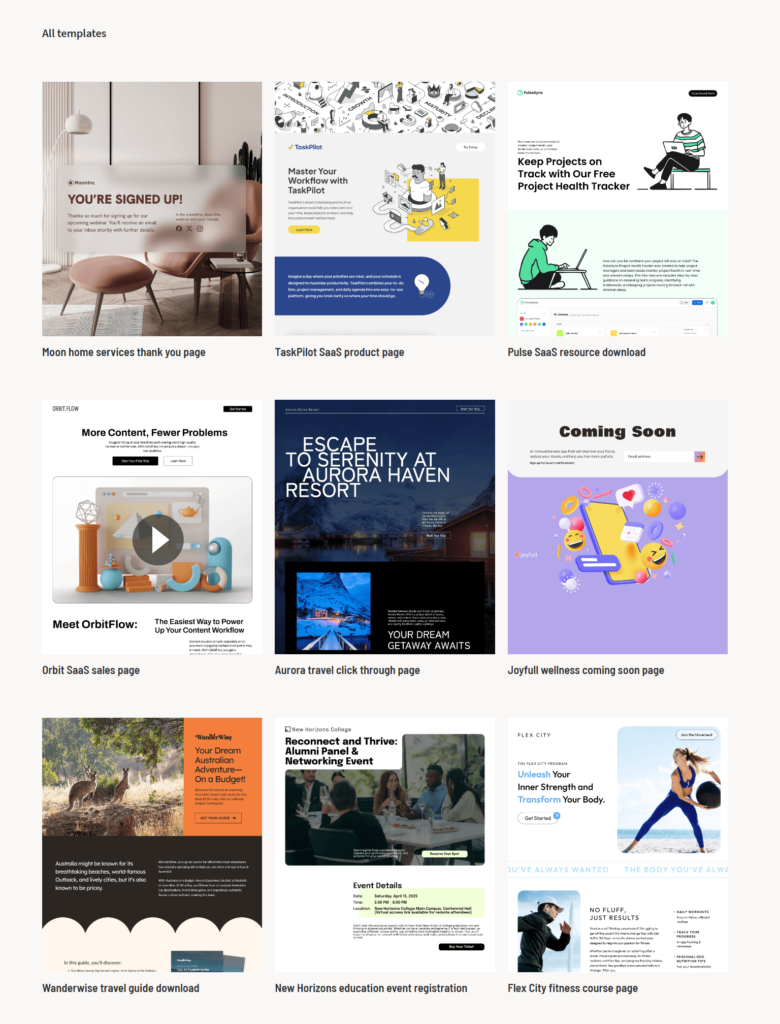
Unbounce templates are designed with conversion optimization in mind, providing a seamless starting point for users who want to create impactful pages quickly. Each template is fully customizable, allowing you to tweak colors, fonts, images, and layouts to match your branding.
One of the standout features of Unbounce’s templates is their mobile responsiveness. Every template is optimized to look great and perform well on both desktop and mobile devices, ensuring a consistent user experience.
Additionally, the platform makes it easy to search for templates based on categories, making it convenient to find a design that aligns with specific campaign objectives. While the templates are a major strength, they are primarily focused on new page creation rather than adapting or optimizing existing designs.
VWO
VWO, unlike Unbounce, does not offer templates for creating landing pages from scratch. Instead, the platform’s strength lies in optimizing and experimenting with the designs of your existing pages. VWO empowers users to test various elements of their web pages, such as headlines, call-to-action buttons, layouts, and visuals, through its advanced A/B and multivariate testing tools.
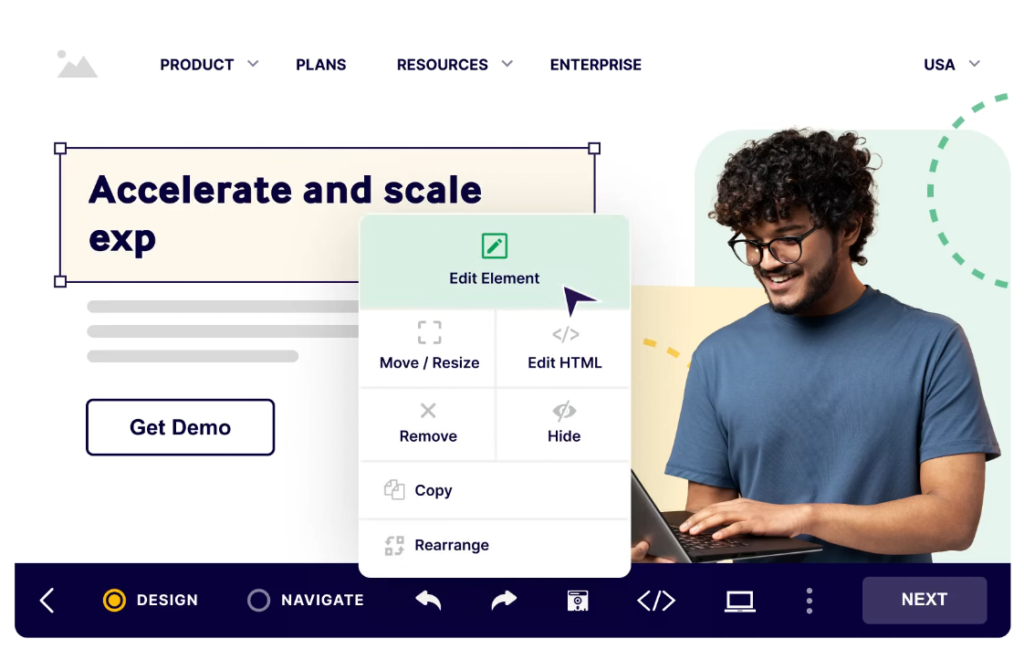
For businesses looking to improve the performance of their current pages, VWO provides the tools to identify what works and what doesn’t. While you won’t find a library of ready-made templates, VWO compensates with its heatmaps and session recordings, which help visualize user interactions and behaviors. These insights are invaluable for refining your pages and ensuring that they align with user preferences and expectations.
In summary, Unbounce is the ideal choice if you need a variety of templates to quickly create new landing pages, while VWO focuses on improving the performance of existing designs through data-driven optimization. Both platforms take different approaches to templates, each serving distinct needs in the conversion optimization journey.
Unbounce vs VWO: A/B Testing
Unbounce
Unbounce provides a straightforward A/B testing functionality designed to help marketers optimize their landing pages with minimal effort. Once you’ve created your page, Unbounce allows you to create variations of it by testing different headlines, images, buttons, or other elements. The platform then splits traffic between these versions and collects performance data to identify the most effective design.
While Unbounce’s A/B testing is easy to set up and use, it is relatively basic compared to more advanced experimentation platforms. It’s ideal for marketers who want to test simple changes and quickly implement improvements to their landing pages.
However, the lack of multivariate testing or advanced analytics may limit the scope of experimentation for users who require in-depth insights or wish to test more complex hypotheses. Unbounce’s A/B testing works seamlessly within its page builder, making it a convenient tool for iterative improvement, but it may not satisfy users looking for detailed behavioral analysis.
VWO
VWO stands out as a comprehensive solution for A/B testing and experimentation. Its advanced testing capabilities go beyond simple split tests, enabling users to run multivariate tests and split URL tests.
This flexibility allows businesses to experiment with multiple changes simultaneously or test entirely different page designs to determine what drives conversions most effectively. VWO’s testing framework is backed by robust analytics, which provide deeper insights into user behavior, including metrics such as time spent on the page, click-through rates, and engagement patterns.
In addition to its A/B testing tools, VWO integrates seamlessly with heatmaps, session recordings, and funnel analysis, making it possible to identify precise areas of improvement on your pages. These insights can then be applied to create and test new hypotheses.
While VWO’s testing features are incredibly powerful, they do require a bit more technical expertise to set up and interpret. For teams that are comfortable diving into data and managing more complex testing setups, VWO offers unparalleled capabilities for maximizing conversion rates.
In essence, Unbounce offers a simpler, more accessible solution for A/B testing, suitable for straightforward optimizations and quick wins. VWO, on the other hand, caters to businesses that need advanced testing tools and data-rich insights to fine-tune their web pages for optimal performance.
The choice between the two will largely depend on the complexity of your testing needs and the level of analysis you require.
Unbounce vs VWO: Conversion Rate Optimization Tools
Unbounce
Unbounce is designed to help businesses create and optimize high-converting landing pages quickly. Its primary conversion rate optimization (CRO) tools are seamlessly integrated into its landing page builder, making it simple for marketers to design pages with conversions in mind.
One of the standout features is the Smart Traffic functionality, an AI-driven tool that dynamically directs visitors to the landing page variant most likely to convert based on their behavior. This eliminates the need to manually analyze A/B test results and provides actionable improvements in real-time.
Additionally, Unbounce offers features such as customizable pop-ups and sticky bars that enhance lead capture and engagement. These tools are designed to help marketers create targeted, non-intrusive prompts that encourage action without overwhelming the user. The platform also includes basic analytics, such as conversion tracking, to monitor performance and identify opportunities for improvement.
However, Unbounce’s CRO capabilities are primarily focused on creating new assets rather than optimizing existing pages, making it an excellent choice for building conversion-friendly pages from scratch but less suited for in-depth experimentation.
VWO
VWO is a comprehensive CRO platform tailored for businesses that want to refine and enhance their existing web pages through data-driven insights. Its suite of tools includes advanced A/B and multivariate testing, heatmaps, session recordings, and funnel analysis. These features allow users to pinpoint exactly where visitors drop off and what elements drive engagement.
VWO goes beyond simple testing by providing actionable insights that help marketers make informed decisions about how to improve their website’s conversion rates.
A standout feature of VWO is its personalization capabilities, enabling businesses to tailor the user experience based on specific audience segments, behaviors, or demographics. The platform also includes advanced analytics and reporting tools, which provide granular details on user interactions.
VWO’s integrations with heatmaps and session recordings give a visual representation of user behavior, helping businesses understand how visitors interact with their pages and where potential barriers to conversion exist.
VWO’s CRO tools are ideal for teams that have the resources and expertise to interpret data and implement strategic changes. While it doesn’t provide tools for creating new landing pages, its optimization features make it a powerful solution for businesses looking to extract the maximum value from their existing web assets.
In summary, Unbounce is best suited for marketers who want to create and optimize new landing pages quickly with user-friendly CRO tools, while VWO is ideal for businesses that prioritize data-driven experimentation and the optimization of existing pages. Both platforms excel in their respective areas, offering unique strengths to meet different CRO needs.
Unbounce vs VWO: Personalization and Targeting
Unbounce
Unbounce focuses on providing tools that allow marketers to create personalized experiences through landing pages, pop-ups, and sticky bars. While its personalization features are not as advanced as VWO’s, Unbounce offers some basic targeting options that can significantly enhance user engagement.
For example, marketers can set specific triggers and rules for pop-ups and sticky bars, such as exit intent, time delays, or scroll depth, ensuring that visitors see the most relevant content at the right time.
Additionally, Unbounce’s Smart Traffic feature leverages AI to analyze visitor behavior and automatically direct users to the landing page variant most likely to convert. This form of dynamic personalization doesn’t require deep technical knowledge and provides a quick way to improve the effectiveness of campaigns.
While Unbounce lacks granular targeting options or behavior-based personalization, its tools are straightforward and effective for marketers looking to deliver relevant content to different audience segments without delving into complex data analysis.
VWO
VWO excels in the realm of personalization and targeting, offering a robust suite of tools to create tailored user experiences based on a wide range of criteria. The platform enables businesses to customize their website content dynamically, targeting specific audience segments based on factors such as location, device type, referral source, and user behavior. This makes it possible to deliver highly relevant experiences that resonate with different groups of visitors.
One of VWO’s standout features is its personalization engine, which integrates seamlessly with its testing and analytics tools. Marketers can analyze user behavior through heatmaps, session recordings, and funnel reports, then use these insights to create targeted campaigns.
For example, you can design personalized offers for returning users, adjust messaging for different geographic regions, or display unique CTAs for specific user demographics. VWO also supports multi-step personalization, allowing marketers to craft experiences that evolve as users navigate through their website.
While VWO’s personalization capabilities are incredibly powerful, they do require a deeper understanding of user data and some technical expertise to fully leverage. For teams that have the resources to dive into advanced targeting and behavioral segmentation, VWO provides unparalleled tools to boost engagement and conversions.
In summary, Unbounce offers straightforward, user-friendly personalization options best suited for quick wins and non-technical marketers, while VWO provides a more comprehensive and data-driven approach to targeting and personalization, ideal for businesses looking to implement sophisticated, behavior-based strategies.
Both platforms cater to different needs, depending on the level of targeting complexity required.
Unbounce vs VWO: Analytics and Reporting
Unbounce
Unbounce provides basic analytics and reporting tools to help marketers track the performance of their landing pages and other campaigns. The platform’s built-in dashboard displays essential metrics, such as page views, conversions, and conversion rates, allowing users to get a quick overview of how their pages are performing.
Additionally, Unbounce includes features like conversion tracking for specific actions, such as form submissions or button clicks, enabling users to gauge the success of individual elements on their landing pages.
While these analytics are sufficient for monitoring campaign performance at a high level, Unbounce’s reporting capabilities are not as robust as those of more advanced platforms. For example, the platform lacks detailed behavioral insights, such as heatmaps or session recordings, which can reveal how users interact with a page.
Unbounce is best suited for users who need straightforward, actionable insights to improve their pages but don’t require in-depth analysis or custom reporting features.
VWO
VWO offers a comprehensive suite of analytics and reporting tools that go far beyond basic performance metrics. The platform provides in-depth insights into user behavior through features like heatmaps, session recordings, and click maps, which visually display how visitors interact with web pages.
These tools help identify areas of interest, friction points, and opportunities for improvement, offering a more granular understanding of user behavior.
VWO also includes funnel analysis, allowing marketers to track the user journey and pinpoint where visitors drop off. This is particularly useful for identifying bottlenecks in the conversion process.
Furthermore, VWO’s reporting features are highly customizable, enabling users to segment data based on variables like device type, geography, or referral source. For teams that rely heavily on data-driven decision-making, VWO’s analytics provide the depth and flexibility needed to inform and refine marketing strategies.
In summary, Unbounce delivers basic analytics that are easy to use and understand, making it a good option for users who need quick insights without diving into complex data.
On the other hand, VWO’s analytics and reporting tools are far more advanced, catering to businesses that require detailed user behavior insights and customizable reports to optimize their web assets. The choice between the two depends on whether you prioritize simplicity or the ability to analyze user interactions in greater detail.
Unbounce vs VWO: Integrations
Unbounce
Unbounce offers a wide range of integrations, making it a versatile tool for connecting with other platforms in your marketing stack.
The platform seamlessly integrates with popular CRM systems, email marketing tools, and analytics software, enabling users to streamline their workflows and manage campaigns efficiently.
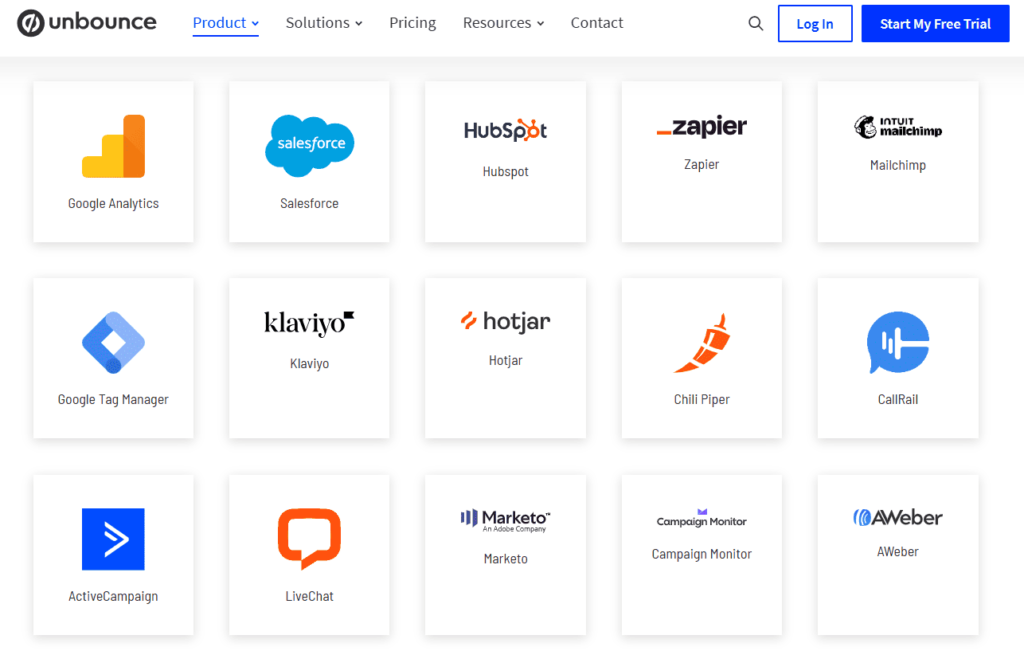
Notable integrations include HubSpot, Salesforce, Marketo, Mailchimp, and ActiveCampaign. Additionally, Unbounce provides access to thousands of third-party tools through its Zapier integration, offering even greater flexibility.
For businesses focused on lead generation, Unbounce’s native integrations with email marketing and CRM platforms simplify the process of capturing and nurturing leads. You can set up automated workflows to send form submissions directly to your preferred tools, ensuring that no leads fall through the cracks.
While Unbounce’s integrations are robust for marketing-focused applications, the platform’s connectivity is primarily centered around landing page performance rather than broader experimentation or in-depth behavioral analysis.
VWO
VWO also offers extensive integration capabilities, but its focus is slightly different from Unbounce. The platform integrates with a variety of analytics tools, customer data platforms, and marketing automation systems to support its advanced testing and optimization features.
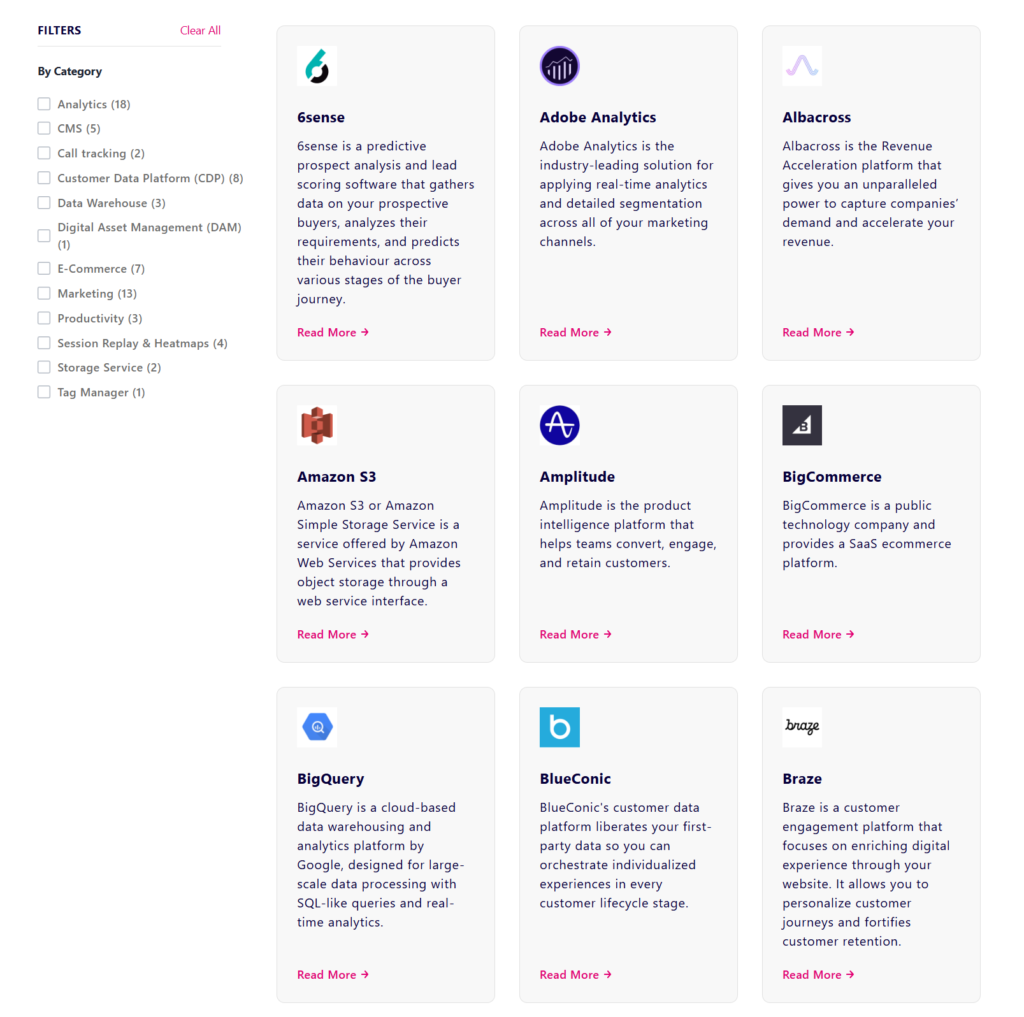
Native integrations with tools like Google Analytics, Adobe Analytics, HubSpot, and Salesforce make it easy to incorporate VWO into an existing marketing ecosystem.
One area where VWO excels is in connecting with advanced analytics and tracking tools. For example, VWO can integrate with heatmapping tools and data visualization platforms, providing a more comprehensive view of user behavior and campaign performance.
Additionally, VWO offers integration with tools like Optimizely and Heap for businesses that rely on multiple optimization platforms. For custom use cases, VWO also supports API integrations, giving developers the flexibility to build tailored solutions.
In summary, Unbounce’s integrations are designed to complement its landing page and lead generation capabilities, while VWO’s integrations focus on enhancing its testing and optimization ecosystem. Both platforms support a wide array of tools, but the choice between them depends on whether your primary goal is managing leads and marketing workflows (Unbounce) or conducting in-depth analysis and experimentation (VWO).
Unbounce vs VWO: Pricing
Unbounce
Unbounce offers tiered pricing plans designed to accommodate businesses of different sizes and needs.
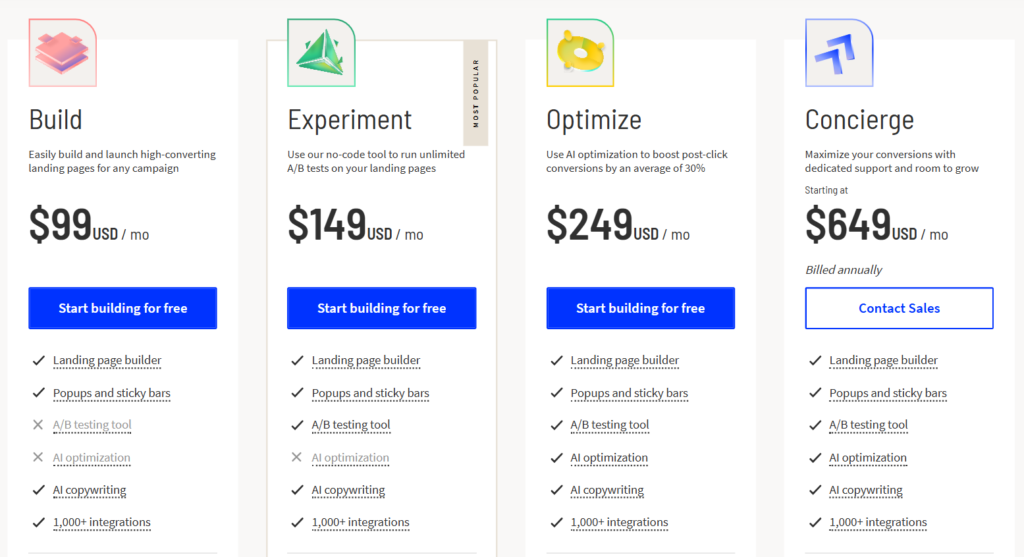
The plans are straightforward, with options for both monthly and annual billing. The pricing starts at $99 per month for the Launch plan, which includes basic features like the landing page builder, unlimited pop-ups and sticky bars, and 20,000 monthly visitors.
The next tier, Optimize, costs $135 per month and adds A/B testing and advanced targeting options for pop-ups and sticky bars.
For businesses requiring more extensive features, the Accelerate plan is priced at $225 per month and includes up to 50,000 monthly visitors, AMP pages, and higher limits on custom domains.
Unbounce also offers a custom plan for larger enterprises with specific needs, providing personalized support and additional features tailored to high-scale campaigns.
Discounts are available for annual billing, making the platform more cost-effective for long-term users. While Unbounce’s pricing reflects its focus on providing a robust landing page solution, it may seem steep for businesses that only need basic tools for smaller campaigns.
VWO
VWO’s pricing is not as transparent as Unbounce’s and typically requires businesses to request a custom quote based on their specific needs.
The platform’s pricing model is designed to reflect its advanced testing and analytics capabilities, with costs depending on the tools and features required, as well as the amount of traffic being tested.
For smaller businesses or those looking for basic A/B testing features, VWO offers entry-level packages that are competitively priced compared to similar platforms.
However, for organizations seeking access to its full suite of features—including multivariate testing, heatmaps, funnel analysis, and personalization—the pricing can become significantly higher.
VWO’s approach to pricing makes it more flexible for businesses with unique requirements, but it may pose a challenge for smaller companies looking for a straightforward pricing structure. For teams that prioritize advanced optimization and are willing to invest in data-driven CRO strategies, VWO’s pricing can deliver strong ROI.
In conclusion, Unbounce provides a clear, tiered pricing structure suited for businesses focusing on creating and optimizing landing pages. VWO’s pricing, while less transparent, offers flexibility for businesses looking for advanced testing and behavioral analytics tools. The choice between the two will largely depend on your budget and the specific features your marketing strategy requires.
Unbounce vs VWO: Unique Features
Unbounce
Unbounce stands out with its unique features that cater to marketers looking to create and optimize landing pages without technical expertise.
One of its key offerings is the Smart Traffic functionality, an AI-driven feature that dynamically routes visitors to the landing page variant most likely to convert based on their behavior. This feature not only simplifies the optimization process but also provides real-time results, allowing marketers to achieve better outcomes with minimal manual effort.
The platform also includes pop-ups and sticky bars, which can be customized and triggered based on user behavior, such as time on page, exit intent, or scroll depth. These tools are designed to engage visitors at critical moments, enhancing conversion opportunities.
Another standout aspect is Unbounce’s drag-and-drop page builder, which provides full creative freedom to design responsive, high-converting landing pages without requiring coding skills.
Unbounce’s template library, optimized for various industries and conversion goals, adds to its appeal by offering a head start on landing page creation. Combined with its seamless integrations with major CRM and email marketing tools, Unbounce provides a complete ecosystem for marketers aiming to create and manage impactful campaigns.
VWO
VWO’s unique features revolve around its advanced capabilities in conversion rate optimization and experimentation. The platform offers heatmaps and session recordings, which provide visual insights into user behavior by tracking clicks, scrolls, and navigation patterns. These tools help businesses understand how visitors interact with their pages, enabling more informed decisions about what to optimize.
VWO’s funnel analysis is another standout feature, allowing marketers to identify where users drop off in the conversion journey. This insight is crucial for uncovering bottlenecks and improving the user experience.
Additionally, VWO excels in personalization, offering tools to deliver tailored experiences based on user behavior, location, and demographics. Its A/B testing and multivariate testing capabilities are particularly robust, supporting complex experiments to fine-tune web pages and campaigns.
For businesses focused on collaboration, VWO provides tools for team management and feedback, making it easier for teams to work together on optimization projects. Its API support and advanced integrations also enable customization and flexibility for unique use cases.
In summary, Unbounce’s unique features are centered on simplifying landing page creation and optimization, making it a go-to platform for marketers seeking efficiency and ease of use.
On the other hand, VWO’s focus on in-depth analytics and testing makes it the preferred choice for businesses that prioritize data-driven experimentation and comprehensive CRO strategies. Both platforms excel in their niches, offering distinct advantages to meet different marketing goals.
The Verdict: Which Platform is Right for You?
Choosing between Unbounce and VWO ultimately depends on your specific goals, resources, and marketing strategy. Both platforms excel in their respective areas, offering unique strengths tailored to different needs.
If you’re looking for a user-friendly tool to create high-converting landing pages quickly and efficiently, Unbounce is the ideal choice. Its drag-and-drop builder, Smart Traffic feature, and customizable pop-ups and sticky bars make it an excellent option for marketers who prioritize ease of use and speed in launching campaigns.
Unbounce is best suited for businesses focused on creating new landing pages and driving conversions without diving too deep into analytics or complex experimentation.
On the other hand, VWO is the go-to platform for businesses that want to maximize the performance of their existing web pages through data-driven insights and rigorous testing. Its robust suite of tools, including advanced A/B and multivariate testing, heatmaps, session recordings, and personalization capabilities, makes it a powerful solution for teams committed to optimizing the user experience and driving long-term growth. However, VWO’s learning curve and technical requirements may demand more expertise and resources.
For businesses seeking a more straightforward approach to landing page creation, Unbounce is a better fit. For those looking to refine their CRO strategy through in-depth experimentation and behavioral analysis, VWO is the superior choice.
Ultimately, the decision comes down to whether you need a platform to create and manage landing pages or one to optimize and perfect the performance of your existing assets. Either way, both Unbounce and VWO are valuable tools that can elevate your marketing efforts when aligned with your goals.
Instapage: The Better Alternative?
For businesses searching for a versatile platform that balances robust features with ease of use, Instapage emerges as a compelling alternative to both Unbounce and VWO.
Known for its advanced capabilities in landing page creation, personalization, and analytics, Instapage provides tools that cater to both beginners and experienced marketers.
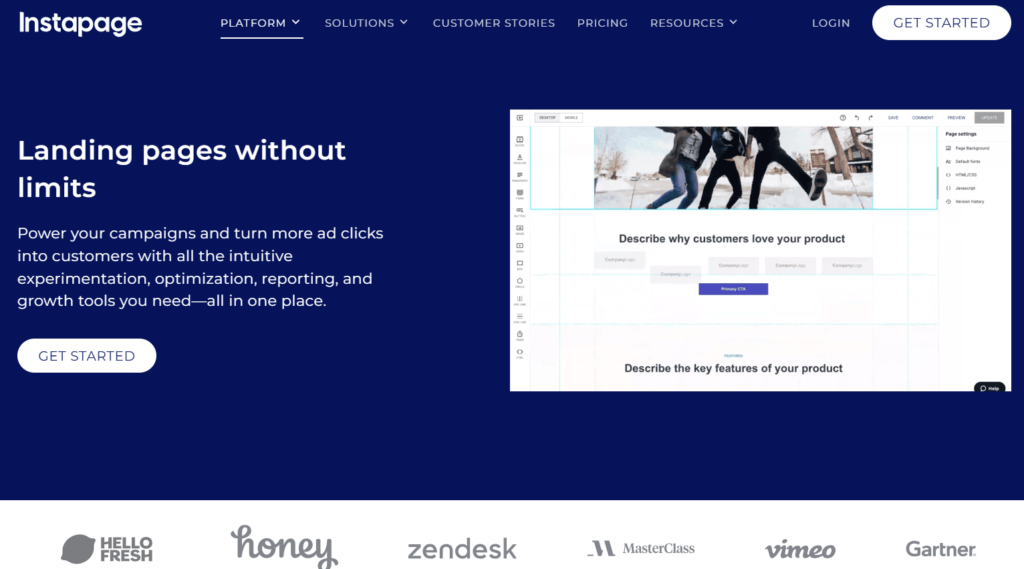
One of Instapage’s standout features is its drag-and-drop builder, which allows users to create pixel-perfect, responsive landing pages without requiring developer expertise. With advanced features like Global Blocks and Dynamic Text Replacement, Instapage enables marketers to maintain consistent branding across campaigns while tailoring messaging to specific audience segments.
Instapage also shines in its collaboration tools, offering real-time visual collaboration that makes it easy for teams to share feedback and edit projects simultaneously. This feature is particularly useful for agencies and large teams managing multiple campaigns.
When it comes to pricing, Instapage offers three plans tailored to different business needs. The Create plan, priced at $99 per month, is ideal for those looking to build responsive landing pages and includes essential tools like reusable page blocks and triggered pop-ups.
For marketers focused on experimentation and lead generation, the Optimize plan, at $199 per month, provides advanced features such as server-side A/B testing and hypothesis tracking. Lastly, the Convert plan offers custom pricing and includes enterprise-level features like heatmaps, audit logs, and direct lead bypass, catering to larger organizations with sophisticated requirements.
Overall, Instapage combines the user-friendly design of platforms like Unbounce with the advanced analytics and testing features often associated with VWO. This makes it a strong contender for businesses seeking an all-in-one solution for landing page optimization and campaign management.
Whether you’re creating pages from scratch or refining existing assets, Instapage provides the tools needed to maximize conversions and streamline workflows, making it a worthwhile alternative to explore.
Frequently Asked Questions:
What is Unbounce best for?
Unbounce is best for businesses and marketers who want to create high-converting landing pages quickly and efficiently without needing technical expertise. Its drag-and-drop builder and Smart Traffic feature make it ideal for launching campaigns with minimal effort.
What is VWO best for?
VWO is tailored for businesses focused on conversion rate optimization. It excels in providing advanced tools like A/B and multivariate testing, heatmaps, session recordings, and personalization to refine and optimize existing web pages for better performance.
How much does Unbounce cost?
Unbounce offers three pricing plans:
- Create: $99 per month (15,000 unique monthly visitors)
- Optimize: $199 per month (30,000 unique monthly visitors)
- Convert: Custom pricing for enterprise features like heatmaps and audit logs.
Each plan includes unlimited conversions and offers a 14-day free trial.
How much does VWO cost?
VWO’s pricing is custom and depends on the specific features and traffic volume required. Businesses must contact the VWO team to receive a personalized quote based on their optimization and testing needs.
Is Instapage a better alternative to Unbounce and VWO?
Instapage serves as a balanced alternative, combining advanced landing page creation tools with robust optimization features. Its three-tiered pricing structure, starting at $99 per month, caters to a wide range of businesses, making it a strong contender for those seeking a versatile solution for both building and optimizing campaigns.
Read more related blog post:
Unbounce Coupon Code: Get Upto 35% Discount